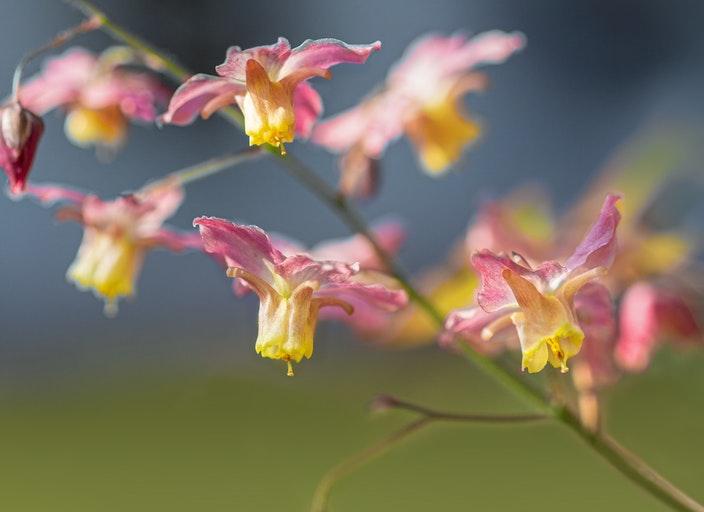
A group of plants in the genus Epimedium are referred to as carpeting perennials. Numerous types of these spring flowering plants, which are native to forests in Asia and the Mediterranean, thrive in shade and rock gardens, beneath trees, and provide a splash of spring color to the landscape. Most will gradually fill up a chosen area with woody rhizomes, without overrunning the garden or displacing other desirable plants. In locations that are partly shaded and where other plants may struggle to flourish, epimediums are a perfect complement that function well as ground cover plants.
The majority of Epimedium plants have red-marked leaves that are fashioned like hearts or arrows. In the spring, they produce delicate blooms with four petals each. The blooms seem to float above the plant and are supported by arched, leafless stems that resemble butterfly wings. They come in a variety of colors, including red, pink, purple, white, yellow, and orange, and at first look they may resemble orchid flowers. Several herb species from the Epimedum genus have been utilized in Chinese traditional medicine, but little is known about this plant's potential health benefits.
Care Epimedium
Epimedium plants often need little maintenance. Mediterranean variants often have year-round, beautiful foliage and are evergreen. Compared to Asian types, which wither away in the winter, these kinds are thought to be more drought resistant. Depending on the type, autumn leaves may become red, yellow, or bronze. These tolerant ground cover plants don't often battle pests or illnesses. Slugs and rabbits may nibble on the leaves, but they seldom do any long-term damage. These plants may be harmed by mosaic virus and vine weevils, however.
The epimedium's native habitat is woodland, therefore replicating that setting will provide the plants the conditions they need to flourish. They take pleasure in the leaf mulch that results from the trees' dappled shade. It is best to plant them next to trees and to add compost or leaf mold every year.
Light
These plants enjoy dappled or patchy illumination. They make an excellent option for shade gardens as well, although they should not be planted in full sun. They flourish next to bigger buildings or behind trees that protect them from the glaring afternoon light.
Soil
When other plants may suffer in dry, rocky soil, epimedium plants thrive. They are thought to withstand drought, particularly the Mediterranean variety. They thrive when planted next to trees because they are good at handling root competition. Although they may tolerate dry, rocky soils, they thrive in rich soil with good drainage and cannot tolerate wet circumstances.
The cultivar being planted determines the ideal pH values for the soil. Typically, neutral to slightly acidic soil conditions are preferred by the majority of Epimediums.
Water
Once established, Epimedium plants do not need a regular watering regimen since they are drought-tolerant. Water sparingly, ensuring that water drains well and does not pool or make the ground soggy, and only when the soil starts to feel dry. Consistent watering is necessary to aid in the establishment of new plants.
Thermodynamics and Humidity
Hardy tiny epimedium plants may be planted in USDA hardiness zones 5 to 8. They can withstand a variety of temperature and humidity conditions. However, extreme heat may burn the leaves, as that from the summer sun.
Fertilizer
Epimedium plants benefit from annual amendments of compost or leaf mold since they often thrive in wooded environments or beneath trees. Every spring, add this or a slow-release fertilizer.
Epimedium types
Epimedium "Pink Champagne" is a colorful, evergreen cultivar distinguished by its spiky, pink blooms and reddish-bronze leaves.
Epimedium x perralchicum: In the spring and autumn, the leaves of this cultivar become a lovely golden color. It blooms in the spring with little yellow flowers.
Epimedium "Amber Queen": As implied by its name, the "Amber Queen" variety is well-known for its amber-yellow blooms, which start to bloom in the spring and last into mid-summer.
Pruning
Only the evergreen types of Epimedium need pruning. It is ideal to trim the leaves to the ground in the early spring, before the blooms bloom. Since the leaves on these kinds do not fall off, fading leaves must be removed in order to promote new, healthy growth for a gorgeous, bright plant.
Developing Epimedium
Although this ground cover develops slowly, it will ultimately occupy the desired space. Epimedium plants may be divided to produce extra plants for different regions while also keeping them confined. After blooming in the spring or in the late summer to early autumn are the optimal times to divide. A pair of garden snips, a shovel, and gloves are required.
Loosen the dirt around the plant with the shovel.
Gently remove the plant after the dirt is free and the root system is mobile.
Divide the plant by cutting through the root system with the shovel and snips. Make sure the roots and leaves of each division are strong.
Place each division where you want it.
Growing Epimedium From Seed: A Guide
Epimedium grows quickly and easily from seeds. It's important to bear in mind, however, that the seeds will probably result in a plant that is distinct from the mother plant in some ways. Propagation through division is better for identical plants. If you want to start them from seeds, adhere to following guidelines:
To gather the seeds, keep a close eye on the plant. Because they are dropped while still green, the seeds are simple to overlook.
When seeds start to emerge, gather them and plant them right away. Keep the seeds from drying out.
Don't bury them too deeply; just gently cover them with little dirt. Do this outside and let the seeds cold stratify during the winter. Place the containers in the refrigerator for about three months if the seeds were planted inside.
If planted outside, germination will take place in the spring. They will germinate after being taken out of the refrigerator if planted inside.
Keep the ground wet but not drenched. After there is no longer a risk of frost, transplant indoor seedlings outside.
Epimedium Repotting and Potting
Plants from the genus Epimedium are excellent choices for container gardening because to their hardiness and moderate growth. Make sure the container you choose has drainage holes so water may flow freely from the bottom. Prior to planting, amend the soil with compost or leaf mold. Keep the ground wet but not drenched. Simply remove the plant from the container when the epimedium outgrows it and split it.
Plants that overwinter in cold climates do well. During the winter, some types naturally die back, while others are evergreen. As long as they are planted in the proper zones, Epimedium plants do not need any additional care to survive the winter.
Methods for Making Epimedium Bloom
This genus contains plants that have four-petaled, fragile blooms that seem to float above the plant. These blooms may be found in red, pink, orange, yellow, purple, white, or a mix of these colors, depending on the cultivar. While some flowers have smooth, spherical petals, others have spiky petals. These plants seem delicate and refined thanks to all of them.
In the spring, epimedium plants often blossom. Compost or fertilizer should be applied to the plant in the spring, along with appropriate lighting and watering conditions, to promote flowering.
Typical Issues with Epimedium
Epimedium plants are typically trouble-free and fairly resilient. A concern that might arise in addition to the occasional pests described previously is root rot if the soil is not draining adequately.
Wilting, Discolored Leaves
Small, yellow, withering leaves, damp stems, and black, squishy roots are all potential symptoms of root rot. This is brought on by the soil having too much moisture. Cut away any contaminated spots and carefully remove the plant to solve the issue. To improve drainage, soil additives like compost or sand should be applied.
文章
还没有人评论,快来抢沙发!









